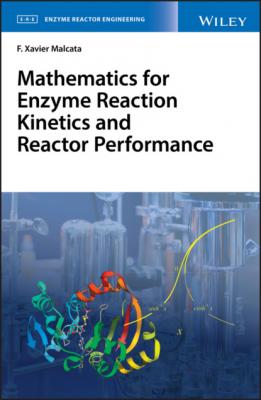Mathematics for Enzyme Reaction Kinetics and Reactor Performance. F. Xavier Malcata
Читать онлайн.| Название | Mathematics for Enzyme Reaction Kinetics and Reactor Performance |
|---|---|
| Автор произведения | F. Xavier Malcata |
| Жанр | Химия |
| Серия | |
| Издательство | Химия |
| Год выпуска | 0 |
| isbn | 9781119490333 |
once n + 1 has been factored out – which retrieves Eq. (2.83) pertaining to a plain arithmetic series, as expected. This conclusion can also be drawn graphically, by comparing the curves labeled as k2 = 1 in Fig. 2.6 with the lines in Fig. 2.4 corresponding to the same
(2.133)
based on Eq. (2.110) and matching Eq. (2.76).
2.2 Multiplication and Division of Polynomials
A polynomial in x refers to a sum of powers of integer exponent on x; such algebraic functions are accordingly the easiest in terms of calculation – including numerical methods, as they basically involve just multiplications and additions. In principle, any continuous function of practical interest may be expressed via a polynomial (as will be derived later); hence, algebraic operations involving polynomials are of the utmost interest for process engineering. Besides the trivial operation of addition – where terms with identical exponents of x are merely lumped, i.e.
(2.134)
with
and
multiplication and division of polynomials appear as germane. An iterated version of the former entails the power of a polynomial, whereas the iterated version of the latter supports factorization of a polynomial – i.e. conversion from a sum to a product of simpler (usually linear) polynomials.
2.2.1 Product
Recalling the two polynomials labeled as Eqs. (2.135) and (2.136) – of nth and mth degree, respectively, one may define their product Pn Pm as an (n + m)th degree polynomial, viz.
(2.137)
upon application of the distributive property of multiplication, one obtains
(2.138)
or else
after lumping powers of x and resorting to a more condensed notation. Of particular interest is having n = m = 1, besides b0 = −a0 and a1 = b1 = 1 – in which case Eq. (2.139) takes the form
Eq. (2.140) entails a notable case of multiplication – since the product of two conjugated binomials, i.e. x + a0 as per Eq. (2.135) and x − a0 as per Eq. (2.136), equals the difference of the squares of their bases, i.e. x2 − a02. This mathematical feature is useful when the terms under scrutiny are square roots (since the product of two irrational functions would turn to a rational function).
2.2.2 Quotient
With regard to division of a dividend polynomial, say, Pn {x}, by a divisor polynomial, say, Pm {x}, one will eventually be led to
on account again of Eqs. (2.135) and (2.136) – provided that n ≥ m; here Qn−m denotes an (n – m)th degree quotient polynomial, and R<m denotes a remainder polynomial of degree not exceeding m. The underlying algorithm is but an extension of Euclidean (long) division algorithm for regular numbers; one should thus start by dividing the highest order term, an xn, of the dividend polynomial by the highest order term, bm xm, of the divisor polynomial – so an xn−m /bm always appears as first term of the quotient polynomial; multiplication should then proceed of said quotient term by every term of the divisor – followed by subtraction of the result from the dividend. In other words, the first step of division should lead to
(2.142)
which simplifies to
after lumping factors and canceling an xn with its negative afterward; this is graphically illustrated in Fig. 2.7.The same algorithm may now be applied to the second term in the right‐hand side of Eq. (2.143), as long as n – 1 ≥ m, to produce
(2.144)
that degenerates to
(2.145)
after lumping the coefficients of similar powers of x – and the process may be iterated for the third term, the fourth term, and so on. The above algorithm is thus to be repeated until the degree of the polynomial in numerator of the last term is lower than its denominator counterpart; it may even reduce to zero – in which case Pn
